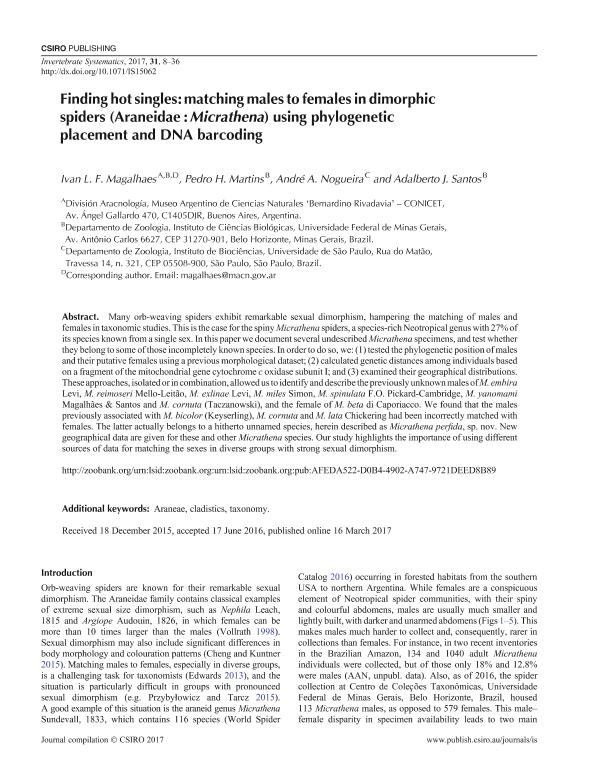Mostrar el registro sencillo del ítem
dc.contributor.author
Fiorini de Magalhaes, Ivan Luiz

dc.contributor.author
Martins, Pedro H.
dc.contributor.author
Nogueira, André A.
dc.contributor.author
Santos, Adalberto J.
dc.date.available
2018-06-13T18:36:12Z
dc.date.issued
2017-03
dc.identifier.citation
Fiorini de Magalhaes, Ivan Luiz; Martins, Pedro H.; Nogueira, André A.; Santos, Adalberto J.; Finding hot singles: matching males to females in dimorphic spiders (Araneidae : Micrathena) using phylogenetic placement and DNA barcoding; Csiro Publishing; Invertebrate Systematics; 31; 1; 3-2017; 8-36
dc.identifier.issn
1445-5226
dc.identifier.uri
http://hdl.handle.net/11336/48569
dc.description.abstract
Many orb-weaving spiders exhibit remarkable sexual dimorphism, hampering the matching of males and females in taxonomic studies. This is the case for the spiny Micrathena spiders, a species-rich Neotropical genus with 27% of its species known from a single sex. In this paper we document several undescribed Micrathena specimens, and test whether they belong to some of those incompletely known species. In order to do so, we: (1) tested the phylogenetic position of males and their putative females using a previous morphological dataset; (2) calculated genetic distances among individuals based on a fragment of the mitochondrial gene cytochrome c oxidase subunit I; and (3) examined their geographical distributions. These approaches, isolated or in combination, allowed us toidentify and describe the previously unknown males ofM. embira Levi, M. reimoseri Mello-Leitão, M. exlinae Levi, M. miles Simon, M. spinulata F.O. Pickard-Cambridge, M. yanomami Magalhães & Santos and M. cornuta (Taczanowski), and the female of M. beta di Caporiacco. We found that the males previously associated with M. bicolor (Keyserling), M. cornuta and M. lata Chickering had been incorrectly matched with females. The latter actually belongs to a hitherto unnamed species, herein described as Micrathena perfida, sp. nov. New geographical data are given for these and other Micrathena species. Our study highlights the importance of using different sources of data for matching the sexes in diverse groups with strong sexual dimorphism.
dc.format
application/pdf
dc.language.iso
eng
dc.publisher
Csiro Publishing

dc.rights
info:eu-repo/semantics/openAccess
dc.rights.uri
https://creativecommons.org/licenses/by-nc-sa/2.5/ar/
dc.subject
Araneae
dc.subject
Cladistics
dc.subject
Taxonomy
dc.subject.classification
Otras Ciencias Biológicas

dc.subject.classification
Ciencias Biológicas

dc.subject.classification
CIENCIAS NATURALES Y EXACTAS

dc.title
Finding hot singles: matching males to females in dimorphic spiders (Araneidae : Micrathena) using phylogenetic placement and DNA barcoding
dc.type
info:eu-repo/semantics/article
dc.type
info:ar-repo/semantics/artículo
dc.type
info:eu-repo/semantics/publishedVersion
dc.date.updated
2018-06-04T13:52:31Z
dc.identifier.eissn
1447-2600
dc.journal.volume
31
dc.journal.number
1
dc.journal.pagination
8-36
dc.journal.pais
Australia

dc.description.fil
Fil: Fiorini de Magalhaes, Ivan Luiz. Consejo Nacional de Investigaciones Científicas y Técnicas. Oficina de Coordinación Administrativa Parque Centenario. Museo Argentino de Ciencias Naturales ; Argentina. Universidade Federal de Minas Gerais; Brasil
dc.description.fil
Fil: Martins, Pedro H.. Universidade Federal de Minas Gerais. Instituto de Ciências Biológicas; Brasil
dc.description.fil
Fil: Nogueira, André A.. Universidade de Sao Paulo; Brasil
dc.description.fil
Fil: Santos, Adalberto J.. Universidade Federal de Minas Gerais. Instituto de Ciências Biológicas; Brasil
dc.journal.title
Invertebrate Systematics

dc.relation.alternativeid
info:eu-repo/semantics/altIdentifier/url/http://www.publish.csiro.au/is/IS15062
dc.relation.alternativeid
info:eu-repo/semantics/altIdentifier/doi/http://dx.doi.org/10.1071/IS15062
Archivos asociados
